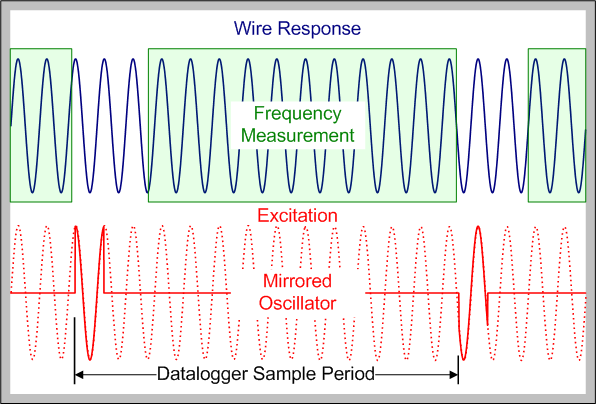Dynamic Measurement
To achieve much higher sampling rates, the dynamic approach compresses the measurement cycle by eliminating the broadband excitation and not allowing the wire oscillation to decay. Figure 1 illustrates the timing of this process.

- If energy is injected precisely into the oscillation at the correct frequency and with the correct phase, a very short excitation waveform with a small amplitude can maintain the resonance of the wire.
- If the excitation is not phase-aligned to the wire motion, the resonance is dampened rather than reinforced.
In between these excitation windows, the wire motion can be sampled, and the resonant frequency determined. Using the newly calculated frequency, the excitation is adjusted slightly, as needed, to track the changes in the resonant frequency of the wire.
The excitation mechanism has very fine frequency resolution to precisely track even very subtle changes in the resonant frequency. As can be seen in Figure 1, there are typically only a few oscillation cycles of the wire available for determining the wire’s resonant frequency. This difficulty is overcome by the VSPECT® algorithm, which can determine the frequency of the wire precisely—even with this short data sample.
An important aspect of the dynamic measurement timing is synchronizing the process to an external timing source that is independent of the wire oscillation. Synchronization has intrinsic benefits to the measurement quality, and it also allows simultaneous sampling of multiple channels. Figure 1 shows that the data logger sample period dictates when the excitations are introduced and when the frequency measurement is made. Because this sample period is independent of the wire motion, the excitation may begin at any point in the phase of the oscillation. When measuring single-coil sensors, it is important to avoid including the excitation in the measurement because this can skew the measured frequency and result in increased measurement noise and a diminished dynamic response.
Synchronization guarantees that the frequency measurement never overlaps the excitation window. The multi-channel simultaneity enabled by time-synchronization is another important benefit when correlating measurements from multiple sensors. Time-synchronized excitation control is a key differentiator between this approach and other auto-resonant coil excitation methods.
